With a slim chance of just one in a million that global warming is not manmade, it’s important we act now to reduce our carbon footprint. In doing so, we all stand a better chance of leaving a more sustainable planet for future generations.
Carbon offsetting is a way to reduce the emissions that you are otherwise unable to. Not only does this help care for your surroundings and local community, but it also helps to combat global climate change. And with unprecedented, unseasonable temperatures recorded this February, there is no better time to act than now.
Ways you’re able to reduce your carbon footprint
Often, a good and relatively easy way to start is by changing your light bulbs to compact fluorescent light bulbs; one bulb alone can reduce up to 1,300 pounds of carbon dioxide pollution during its life span.
Eating less meat is also a realistic way to reduce your carbon footprint – cows and sheep both emit large quantities of methane, a powerful global warming gas. Walking more and using public transport may also be a viable way, should it suit your lifestyle.
Several things used everyday in your home produce greenhouse gases that contribute to global warming; such gases trap the sun’s rays within the atmosphere. Humans contribute to greenhouse gases by increasing the concentration of the likes of methane, carbon dioxide and nitrous oxide through deforestation, energy production, waste disposal and agriculture. With this in mind, consider ways you’re able to reduce energy emissions related to your home.
Your carbon footprint when moving home
 New homes require far less energy to run than older properties, so you can be forgiven for wanting to move.
New homes require far less energy to run than older properties, so you can be forgiven for wanting to move.
You can reduce your carbon footprint when moving home by ensuring it is properly insulated and draught-proofed. Poorly insulated homes require large quantities of energy to heat, so this is one of the most important steps you can take towards sustainability. The house should be in accordance with the climate change bill Australia and net zero pathways.
Old gas and oil boilers can prove hugely wasteful. Even if the current boiler is in working order, it may be worth considering a replacement if it is more than 15-years old. Doing so may see your fuel bill fall by a third, so it’s a double result.
Consider your use of appliances in the home also; frequent use of a dishwasher can seriously drive up your energy consumption, and electricity bill. You could also opt to invest in your own sources of renewable energy when moving into your new home. Solar panels on the roof are a sensible choice, both financially and environmentally. You could even purchase shares in a local, cooperatively owned wind farm.
The actual process of moving home also matters, as does the distance you drive. Generally speaking, reducing the mileage of the average car from 15,000 to 10,000 miles a year will save more than 15% of the average person’s carbon footprint.
What can you do?
Consider the distance from your old home to your new home, and try to limit the number of trips taken. Similarly, use calculators such as that from Compare the Man And Van to determine the size of the removal vehicle you’re going to need. This will help to ensure that you aren’t hiring something oversized when unnecessary, therefore capping your energy consumption during your move.
Article Submitted By Community Writer




